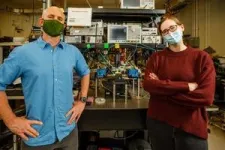(Press-News.org) As the U.S. Environmental Protection Agency cracks down on insidious “forever chemical” pollution in the environment, military and commercial aviation officials are seeking ways to clean up such pollution from decades of use of fire suppressant foams at military air bases and commercial airports.
Fire-suppression foams contain hundreds unhealthful forever chemicals, known by chemists as PFAS or poly- and per-fluoroalkyl substances. These compounds have stubbornly strong fluorine-to-carbon bonds, which allow them to persist indefinitely in the environment, hence the moniker “forever chemicals.” Also found many other products, PFAS compounds now contaminate groundwater supplies tapped by municipal water suppliers at many locations throughout the nation.
Because they are linked to higher risks for certain cancers and other maladies, the EPA imposed a new rule last month requiring water utilities to reduce contamination if levels exceeded 4 parts per trillion for certain PFAS compounds.
Fortunately, a collaborative discovery by scientists at UC Riverside and Clarkson University in Potsdam, N.Y., provides a new strategy to clean up these pollutants.
The method was detailed this month in the journal Nature Water. It involves treating heavily contaminated water with ultra-violet (UV) light, sulfite, and a process called electrochemical oxidation, explained UCR associate professor Jinyong Liu.
“In this work, we continued our research on the UV-based treatment, but this time, we had a collaboration with an electrochemical oxidation expert at Clarkson University,” said Liu, who has published nearly 20 papers on treating PFAS pollutants in contaminated water.. “We put these two steps together and we achieved near-complete destruction of PFAS in various water samples contaminated by the foams.”
Liu said the collaboration with a team led by assistant professor Yang Yang at Clarkson solved major technical problems. For instance, the foams contain various other concentrated organic compounds that hinder the breakup of the strong fluorine-to-carbon bonds in the PFAS compounds.
Liu and Yang, however, found that electrochemical oxidation also breaks up these organics. Their process also allows these reactions to occur at room temperature without a need for additional heat or high pressure to stimulate the reaction.
“In the real world, the contaminated water can be very complicated,” Liu said. “It contains a lot of things that might potentially slow down the reaction.”
PFAS compounds have been used in thousands of products ranging from potato chip bags to non-stick cookware, but fire-suppressing foams are a major source of PFAS pollution in groundwater because have been used for for decades to extinguish aviation fuel fires at hundreds of military sites and commercial airports. These foams were also routinely applied to minor fuel spills as a precautionary measure to prevent fires.
Invented by the U.S. Navy in the 1960s, the foams form an aqueous film around burning gasoline and other flammable liquids, which quickly deprives the fire of oxygen and extinguishes it.
Because of widespread use, the Department of Defense ordered assessments of 715 military sites nationally for PFAS releases and, by the end of last year, found that 574 of these sites need further investigations or cleanups as required by federal law.
PFAS cleanups became more urgent last month when the EPA imposed a new rule requiring water utilities to reduce contamination if levels exceeded 4 parts per trillion for certain PFAS compounds.
Liu said the method he developed with Yang is well suited for cleansing heavily contaminated water used to flush out tanks, hoses, and other firefighting equipment. The method also can be used to treat leftover containers of PFAS-containing foams.
Their method can also help water utilities deal with groundwater pollution. Contaminated groundwater is often treated through ion exchange technologies in which the PFAS molecules glob onto resin beads in large treatment tanks. The UV light and electrochemical oxidation method developed by Liu and Yang also can assist the regeneration of beads so they can be recycled, Liu said.
“We want to have sustainable management of the resin,” Liu said. “We want to reuse it.”
The study’s title is “Near-complete destruction of PFAS in aqueous film-forming foam by integrated photo-electrochemical processes.” In addition to Liu and Yang, its authors are Yunqiao Guan, Zekun Liu, Nanyang Yang, Shasha Yang, and Luz Estefanny Quispe-Cardenas, who are current or former graduate students at UCR and Clarkson.
This research was supported by funding from the U.S. Department of Defense’s Strategic Environmental Research and Development Program.
END
New ‘forever chemical’ cleanup strategy discovered
Method deals with pollution from fire suppressant foams
2024-05-09
ELSE PRESS RELEASES FROM THIS DATE:
Squeezed by neighbors, planet glows with molten lava
2024-05-09
UC Riverside astrophysicist Stephen Kane had to double check his calculations. He wasn’t sure the planet he was studying could be as extreme as it seemed.
Kane never expected to learn that a planet in this faraway star system is covered with so many active volcanoes that seen from a distance it would take on a fiery, glowing-red hue.
“It was one of those discovery moments that you think, ‘wow, it’s amazing this can actually exist,” Kane said. A paper detailing the discovery has been published in The Astronomical Journal.
Launched in 2018, NASA’s Transiting Exoplanet Survey ...
GPS-like system shows promise as HIV vaccine strategy to elicit critical antibodies
2024-05-09
DURHAM, N.C. – A team led by the Duke Human Vaccine Institute (DHVI) has developed a vaccine approach that works like a GPS, guiding the immune system through the specific steps to make broadly neutralizing antibodies against HIV.
Publishing in the journal Cell Host & Microbe, the study describes an approach that provides step-by-step directions for the immune system to generate the elusive, yet necessary antibodies for a successful HIV vaccine.
“HIV is the fastest-evolving virus known. So it’s been a long-standing goal in HIV research to create ...
NSF awards $630,000 to study teeth of non-human primates
2024-05-09
The National Science Foundation awarded $630,444 to Kathleen Paul, an assistant professor of anthropology at the U of A, to provide a comprehensive outline of dental genetic architecture for two primate species of tamarins and macaques.
Paul's research team’s ultimate goal is to harness this information to advance bioanthropological practice, including the use of teeth for reconstructing evolutionary processes and experiences of stress and illness.
No live animals will be used in the research. Instead, skeletonized individuals from collections ...
Discrimination may accelerate aging
2024-05-09
Discrimination may speed up the biological processes of aging, according to a new study led by researchers at the NYU School of Global Public Health.
The research links interpersonal discrimination to changes at the molecular level, revealing a potential root cause of disparities in aging-related illness and death.
“Experiencing discrimination appears to hasten the process of aging, which may be contributing to disease and early mortality and fueling health disparities,” said Adolfo Cuevas, assistant professor in the Department of Social and Behavioral Sciences at NYU’s ...
New machine learning algorithm promises advances in computing
2024-05-09
COLUMBUS, Ohio – Systems controlled by next-generation computing algorithms could give rise to better and more efficient machine learning products, a new study suggests.
Using machine learning tools to create a digital twin, or a virtual copy, of an electronic circuit that exhibits chaotic behavior, researchers found that they were successful at predicting how it would behave and using that information to control it.
Many everyday devices, like thermostats and cruise control, utilize linear controllers – which use ...
How climate change will affect malaria transmission
2024-05-09
University of Leeds news release
Embargoed until 1900 BST, 9 May 2024
How climate change will affect malaria transmission
A new model for predicting the effects of climate change on malaria transmission in Africa could lead to more targeted interventions to control the disease according to a new study.
Previous methods have used rainfall totals to indicate the presence of surface water suitable for breeding mosquitoes, but the research led by the University of Leeds used several climatic and hydrological models to include real-world processes of evaporation, infiltration and flow through rivers.
This ...
Presenting a safer, low-cost, and low-energy whole-body magnetic resonance imaging device
2024-05-09
Machine learning enables cheaper and safer low-power magnetic resonance imaging (MRI) without sacrificing accuracy, according to a new study. According to the authors, these advances pave the way for affordable, patient-centric, and deep learning-powered ultra-low-field (ULF) MRI scanners, addressing unmet clinical needs in diverse healthcare settings worldwide. Magnetic Resonance Imaging (MRI) has revolutionized healthcare, offering noninvasive and radiation-free imaging. It holds immense promise for advancing medical diagnoses through artificial intelligence. However, despite its five decades of development, MRI remains largely inaccessible, particularly ...
Climate models predict larger than expected decline in African malaria transmission areas
2024-05-09
Areas at risk for malaria transmission in Africa may decline more than previously expected because of climate change in the 21st century, suggests an ensemble of environmental and hydrologic models. The combined models predicted that the total area of suitable malaria transmission will start to decline in Africa after 2025 through 2100, including in West Africa and as far east as South Sudan. The new study’s approach captures hydrologic features that are typically missed with standard predictive models of malaria transmission, offering a more nuanced view that could inform malaria control efforts in a warming world. Most of the burden of malaria falls on people living ...
Indian ocean temperature anomalies predict global dengue trends
2024-05-09
Sea surface temperature anomalies in the Indian Ocean predict the magnitude of global dengue epidemics, according to a new study. The findings suggest that the climate indicator could enhance the forecasting and planning for outbreak responses. Dengue – a mosquito-borne flavivirus disease – affects nearly half the world’s population. Currently, there are no specific drugs or vaccines for the disease, and outbreaks can have serious public health and economic impacts. As a result, the ability to predict the risk of outbreaks and prepare accordingly is crucial for many regions where ...
Cubic millimeter fragment of human brain reconstructed at nanoscale resolution
2024-05-09
Using more than 1.4 petabytes of electron microscopy (EM) imaging data, researchers have generated a nanoscale-resolution reconstruction of a millimeter-scale fragment of human cerebral cortex, providing an unprecedented view into the structural organization of brain tissue at the supracellular, cellular, and subcellular levels. The human brain is a vastly complex organ and, to date, little is known about its cellular microstructure, including the synaptic and neural circuits it supports. Disruption of these circuits is known to play a role in myriad brain disorders. Yet studying human brain ...
LAST 30 PRESS RELEASES:
Electrodes created using light
Second-hand gift-giving is a well-deliberated decision
How human interaction drove evolution to make bears less aggressive
National Poll: Few parents offer teens guidance on healthy eating during holiday season
Cannabis derivatives could provide new ovarian cancer treatments
Raising strong yeast as a petroleum substitute
Clues to the origin of hot Jupiters hidden in their orbits
Canada’s reduced pledge to Global Fund will impact domestic health
1 in 4 children with major traumatic injuries not cared for in pediatric trauma centres
Duke and Duke-NUS’ joint cross-population research to uncover "East-West" differences in disease and care
Scientists to ‘spy’ on cancer- immune cell interactions using quantum technology breakthrough
Tech savvy users have most digital concerns
Making lighter work of calculating fluid and heat flow
Normalizing blood sugar can halve heart attack risk
Lowering blood sugar cuts heart attack risk in people with prediabetes
Study links genetic variants to risk of blinding eye disease in premature infants
Non-opioid ‘pain sponge’ therapy halts cartilage degeneration and relieves chronic pain
AI can pick up cultural values by mimicking how kids learn
China’s ecological redlines offer fast track to 30 x 30 global conservation goal
Invisible indoor threats: emerging household contaminants and their growing risks to human health
Adding antibody treatment to chemo boosts outcomes for children with rare cancer
Germline pathogenic variants among women without a history of breast cancer
Tanning beds triple melanoma risk, potentially causing broad DNA damage
Unique bond identified as key to viral infection speed
Indoor tanning makes youthful skin much older on a genetic level
Mouse model sheds new light on the causes and potential solutions to human GI problems linked to muscular dystrophy
The Journal of Nuclear Medicine ahead-of-print tip sheet: December 12, 2025
Smarter tools for peering into the microscopic world
Applications open for funding to conduct research in the Kinsey Institute archives
Global measure underestimates the severity of food insecurity
[Press-News.org] New ‘forever chemical’ cleanup strategy discoveredMethod deals with pollution from fire suppressant foams



